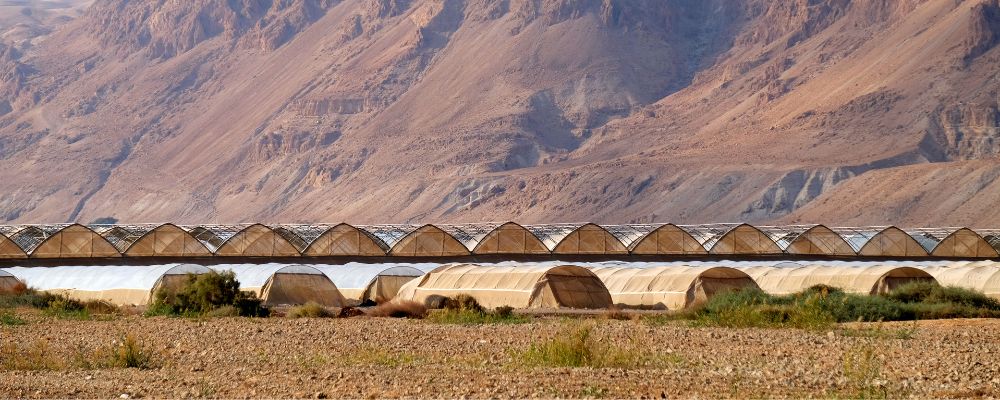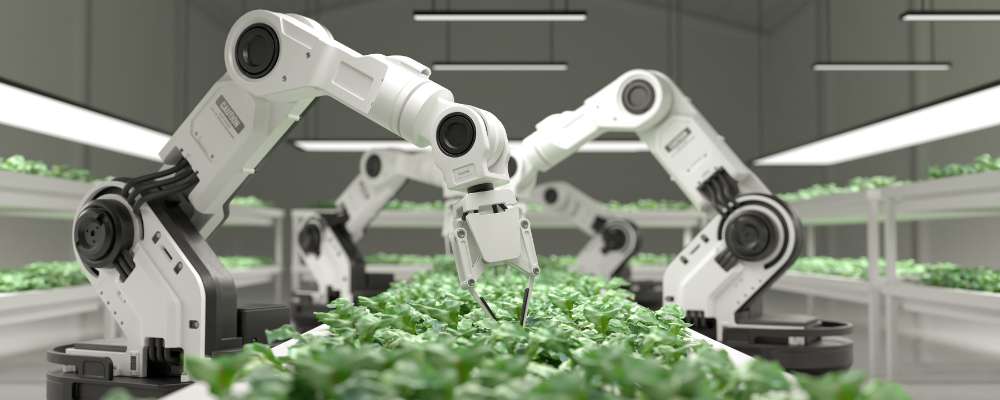How to Set Up Your Own Smart Greenhouse Today
8th May 2023
Are you tired of unpredictable weather and inefficient farming practices? Say hello to smart greenhouses! With advanced technology controlling the climate, lighting, and irrigation, you can grow abundant crops while reducing water usage and helping the environment. In this blog, we'll explore the latest advancements in smart greenhouse technology and share a step-by-step guide for setting up your own. Whether you're a seasoned grower or a novice, this blog will offer valuable insights on how to optimize your yield and minimize costs using automation. Join the farming revolution and discover the exciting potential of smart greenhouses!

What is the New Technology in Greenhouses?
As the world's population continues to grow, the demand for fresh produce increases with it. However, traditional farming methods can no longer sustainably meet this demand. That's where smart greenhouses come in - they provide an innovative solution for sustainable and efficient food production.
Let's take a look at what can be automated in greenhouse. We covered some of the latest innovations in automation for smart greenhouses and their potential benefits.
Precision Farming With IoT and AI
Does greenhouse use AI? Smart greenhouses are utilizing the integration of the Internet of Things (IoT) and Artificial Intelligence (AI) to optimize crop yield and reduce waste. Real-time data on plant health, growth, and environmental conditions from IoT sensors are analyzed by AI algorithms, which enable growers to make informed decisions quickly and efficiently.
Vertical Farming for Maximum Space Utilization
Vertical farming is a popular solution to maximize space utilization and increase fresh produce demand in urban areas. Automated systems can control lighting, water, and nutrient delivery to crops grown in vertical towers or racks, resulting in higher yields per square foot than traditional farming methods. This method reduces labor costs and requires fewer resources, making it an efficient and eco-friendly solution.
Automated Pest and Disease Control
Automation makes it easier to control and prevent pest and disease outbreaks. Automated pest control systems detect and eliminate pests before they cause significant damage. Automated disease detection systems use sensors and AI algorithms to monitor plants and detect diseases early, preventing the spread and minimizing crop loss.
Energy-Efficient Climate Control Systems
Heating and cooling systems can be significant energy consumers in smart greenhouses, but automation can help minimize energy waste. Automated climate control systems optimize temperature, humidity, and ventilation, reducing energy consumption while maintaining optimal growing conditions. Greenhouse growers can reduce their carbon footprint and save on energy costs by implementing automated climate control systems.
Automated Irrigation Systems
Water is a precious resource, and managing it sustainably is critical for smart greenhouse operations. Automated irrigation systems deliver water efficiently to plants, reducing water waste and ensuring optimal soil moisture levels.
Lighting Automation
Lighting automation systems adjust the intensity and duration of light, providing the optimal amount of light for plant growth. This technique can improve plant productivity and reduce energy costs.
Automated Nutrient Management
Automated nutrient management involves monitoring and adjusting the amount of fertilizer and other nutrients delivered to plants. Greenhouse owners can reduce waste and promote healthy growth and higher crop yields by ensuring that plants receive the right amount of nutrients.
Now that you have an understanding of the new technology available for greenhouses, let's dive into how you can set up a smart greenhouse in Dubai. To learn more about how automation can benefit your greenhouse, contact us and read our other blogs.

Setting up a Smart Greenhouse in Dubai: A Step-by-Step Guide
Are you looking to set up your own smart greenhouse in Dubai? Smart greenhouses are an innovative solution for growing crops with greater efficiency and sustainability. They allow for the automation of the growing process, which makes it easier to manage the complex needs of plants and achieve optimal growth. In this step-by-step guide, we'll walk you through the process of setting up your own smart greenhouse in Dubai.
Selecting a Site for Your Smart Greenhouse
Choosing the right location is critical for the success of your smart greenhouse. When selecting a site, consider the following factors:
Analyzing Soil Conditions and Choosing the Right Location
Before selecting a site for your smart greenhouse, it's important to analyze the soil conditions. The soil should be rich in nutrients and have good drainage. Avoid areas with soil that is too sandy or too clayey. Test the soil pH and amend it as necessary to create the right conditions for plant growth.
Assessing Sunlight Exposure and the Impact on Plant Growth
Sunlight exposure is another important factor to consider when selecting a site for your smart greenhouse. Plants need a certain amount of light to grow and thrive. Choose a location with adequate sunlight exposure for the plants you want to grow.
Understanding Drainage and Irrigation Needs
Drainage and irrigation are critical factors for the success of your smart greenhouse. Choose a site with good drainage to prevent waterlogging, which can lead to root rot and other problems. Ensure that your greenhouse has access to a reliable source of water and that your irrigation system is properly designed and installed.
Accessing Reliable Sources of Water and Electricity
Your smart greenhouse will require a reliable source of water and electricity. Choose a location with access to a municipal water supply or consider drilling a well. Ensure that your greenhouse has access to a reliable source of electricity or consider using alternative energy sources such as solar power.
Choosing the Type of Greenhouse Structure
There are many types of greenhouse structures available, including traditional glass greenhouses, polycarbonate greenhouses, and high tunnels. Each type of structure has its own pros and cons. Consider the following factors when choosing the right greenhouse structure for your needs:
- Traditional glass greenhouses are the most common type of greenhouse. They offer excellent light transmission and are highly durable. However, they are also the most expensive type of greenhouse and require more maintenance than other types of structures.
- Polycarbonate greenhouses are a more affordable alternative to traditional glass greenhouses. They are highly durable and offer good light transmission, but not as good as glass greenhouses. Polycarbonate is a plastic material that provides better insulation than glass, making it easier to maintain a consistent temperature inside the greenhouse. They are also lightweight and easy to assemble, which can be an advantage if you plan on moving or expanding your greenhouse in the future.
- High tunnels, also known as hoop houses, are the most affordable option for a greenhouse structure. They are simple and easy to construct, typically consisting of a steel frame covered in polyethylene plastic. While they do not offer the same level of protection as traditional or polycarbonate greenhouses, they are ideal for smaller-scale operations or for growers on a budget. High tunnels are also highly customizable and can be modified to fit the specific needs of your crops.
When choosing a greenhouse structure, it's important to consider factors such as cost, durability, and the specific needs of your crops. Additionally, you should also consider the climate in Dubai and the potential impact of extreme weather conditions such as high temperatures, strong winds, and sandstorms.
Selecting the Appropriate Equipment for Your Greenhouse
In addition to selecting the appropriate greenhouse structure, it's also important to choose the right equipment for your smart greenhouse. Here are some of the key pieces of equipment you may need:
Irrigation Systems
Proper watering is essential for healthy plant growth. There are several types of irrigation systems available, including drip irrigation, sprinkler systems, and flood irrigation. Drip irrigation is the most efficient option, as it delivers water directly to the roots of the plant, reducing water waste and preventing soil erosion.
Heating and Cooling Systems
Dubai is known for its hot and dry climate, which can be challenging for plant growth. To maintain a consistent temperature inside your smart greenhouse, you will need to install a heating and cooling system. Options include forced-air heaters, radiant heaters, evaporative cooling systems, and air conditioning units.
Lighting Systems
In addition to natural sunlight, your smart greenhouse may also require supplemental lighting to ensure optimal plant growth. LED grow lights are the most energy-efficient option, as they consume less electricity than traditional lighting sources and emit less heat.
Sensors and Controllers
Sensors and controllers are essential for automating the growing process in your smart greenhouse. They can be used to monitor environmental conditions such as temperature, humidity, and CO2 levels, and to adjust irrigation, heating, and lighting systems accordingly. Some controllers can also be programmed to send alerts if there are any issues with the growing conditions.
Installing and Configuring Your Equipment
Once you have selected the appropriate equipment for your smart greenhouse, it's time to install and configure it. This may involve hiring a professional installer or doing it yourself if you have the necessary skills and experience. Here are some tips to keep in mind:
- Follow the manufacturer's instructions carefully when installing your equipment to ensure it is set up correctly and safely.
- Make sure that all equipment is properly grounded to prevent electrical hazards.
- Test your equipment before planting any crops to ensure that it is functioning properly.
- Consider hiring a professional to help you set up your sensors and controllers to ensure they are properly calibrated and integrated with your equipment.
Implementing Automation in Your Greenhouse
One of the key advantages of a smart greenhouse is the ability to automate the growing process. This can help you save time and resources while ensuring optimal plant growth. Here are some of the ways you can implement automation in your greenhouse:
- Use sensors and controllers to monitor environmental conditions and adjust equipment accordingly. For example, if the temperature in your greenhouse is too high, your controller can turn on your evaporative cooling system to bring the temperature down.
- Implement an automated irrigation system to ensure that your plants are getting the right amount of water. This can help save water and prevent over or under-watering. Consider using a drip irrigation system, which is more efficient than traditional sprinkler systems and can help reduce the risk of disease by keeping the leaves dry.
In addition to monitoring and adjusting environmental conditions, you may also want to implement an automated fertilization system. This can help ensure that your plants are getting the right nutrients at the right time, which can lead to healthier and more productive plants.
Regular Maintenance and Monitoring
To ensure that your smart greenhouse continues to operate efficiently and effectively, it's important to perform regular maintenance and monitoring. This can include:
- Checking and adjusting environmental conditions on a regular basis, such as temperature, humidity, and CO2 levels
- Monitoring plant growth and health, and addressing any issues that arise promptly
- Performing routine maintenance on your equipment, such as cleaning filters and replacing worn parts
- Checking for pests and diseases regularly and implementing appropriate control measures
By performing regular maintenance and monitoring, you can help prevent small issues from becoming bigger problems that could affect your crop yields.
Now that you have a step-by-step guide to setting up a smart greenhouse in Dubai, it's important to understand the challenges that come with automating your operations. In the following section, we'll explore some common challenges faced by greenhouse growers in Dubai when implementing automation and provide tips and strategies for overcoming them.
Overcoming Challenges in Automating Greenhouses in Dubai
As technology continues to advance, greenhouse growers in Dubai are seeking ways to improve their operations by implementing automation. However, this approach presents a number of challenges that growers must overcome in order to fully benefit from it. In this guide, we will explore common challenges faced by greenhouse growers in Dubai when automating their operations, and offer tips and strategies to overcome them.
Climate Challenges
Dubai's hot and humid climate presents a significant challenge for greenhouse growers looking to automate their operations. High temperatures and humidity can damage equipment, negatively impact plant growth, and shorten the lifespan of sensors and controllers. To address this challenge, growers should invest in equipment that is specifically designed for high-temperature and high-humidity environments. In addition, regular equipment maintenance and cleaning can help prolong its lifespan and prevent malfunctions.
Water Scarcity
Water scarcity is a major concern in Dubai, and greenhouse growers must be conscious of their water usage. Automating irrigation systems can help reduce water waste and ensure that plants receive the appropriate amount of water. Growers should also consider using recycled or desalinated water to reduce their reliance on freshwater sources.
Power Supply Challenges
While Dubai's power grid is generally reliable, occasional power outages and interruptions can occur. These disruptions can have serious consequences for automated greenhouse systems that rely on a consistent power supply to function properly. To overcome this challenge, growers should invest in backup power sources such as generators or batteries. Implementing power-saving measures such as using energy-efficient lighting and equipment can also help reduce the strain on the power grid and prevent outages.
Cultural Considerations
Greenhouse growers in Dubai must be mindful of cultural considerations when implementing automation due to the city's multicultural makeup. Workers may have different attitudes towards automation or may require training to use new equipment.
Security Risks
Automated systems are vulnerable to cyber-attacks, and growers must take steps to secure their systems and data. This includes implementing strong passwords, regularly updating software, and limiting access to sensitive data.
Maintenance
Automated systems require regular maintenance to function efficiently and effectively. This can be challenging for growers who may not have the time or resources to maintain their systems. To overcome this challenge, growers can consider outsourcing maintenance to third-party providers or investing in self-maintaining equipment.
Integration with Existing Systems
Many greenhouse growers already have established systems and infrastructure in place. Integrating new automated systems with existing ones can be challenging and require careful planning and coordination. Growers must consider factors such as compatibility, scalability, and potential disruptions to ongoing operations.
Limited Expertise and Resources
Automating a greenhouse operation requires specialized knowledge and expertise, which may not be readily available in Dubai. In addition, the cost of equipment and software can be prohibitive for some growers. To overcome this challenge, growers should collaborate with experts and other growers to share knowledge and resources. They can also seek out funding opportunities from government or private sources to help offset the costs of automation.
By addressing these challenges, greenhouse growers in Dubai can successfully implement automation in their operations and experience increased efficiency and yield. With careful planning, research, and collaboration, automation can be a game-changer for greenhouse growers in Dubai.
If you're a greenhouse grower in Dubai looking to overcome the challenges of automating your operations, FSE Group can help. Our team of experts can provide the knowledge, resources, and funding opportunities you need to successfully implement automation in your greenhouse. Contact us today to learn more about how we can help you achieve greater efficiency and yield in your operations.
Conclusion
In conclusion, setting up a smart greenhouse is a game-changer for modern farming, and Dubai is leading the way in adopting this technology. With the step-by-step guide and strategies for overcoming challenges discussed in this blog, anyone can set up their own smart greenhouse and enjoy the benefits of optimal crop growth, reduced water usage, and improved sustainability. By embracing this new technology, we can revolutionize the future of farming and create a more efficient and eco-friendlier world for generations to come.
We encourage readers to take action and implement automation in their greenhouses for optimal plant growth and profitability. If you have any questions or need further guidance, don't hesitate to contact FSE Group. Additionally, check out How Smart Greenhouses Increase Crop Production by 70% and Switching to Smart Greenhouses: The Smart Choice for Farmers blogs for more valuable insights and resources. Thank you for taking the time to read this guide, and we wish you all the best in your smart greenhouse endeavors!

